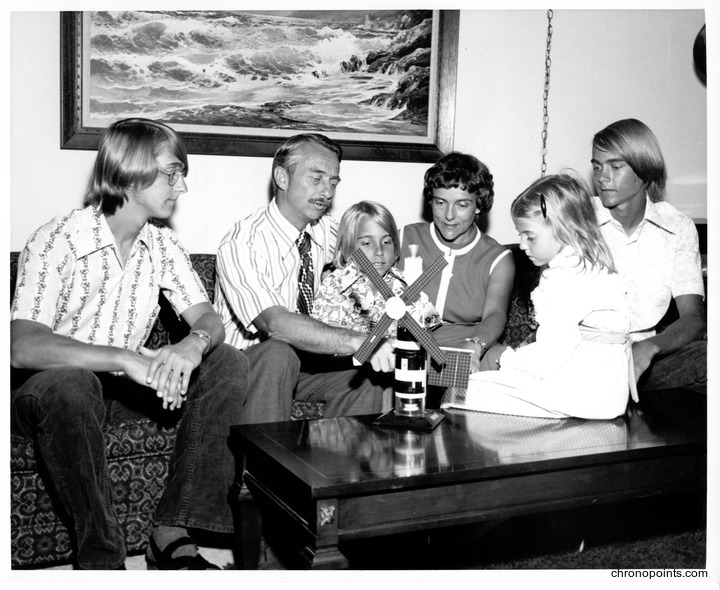Skylab 3 Astronaut Owen K. Garriott and Family
Dublin Core
Title
Skylab 3 Astronaut Owen K. Garriott and Family
Alternative Title
Astronaut Garriott and Family
Subject
National Aeronautics and Space Administration (U.S.)
NASA
Garriott, Owen K., 1930-
Astronauts--United States
Skylab Program
Description
Skylab 3's Science Pilot Owen K. Garriott (1930-) with his family. To his left are Richard Allen Garriott (1961-), Helen Mary Walker Garriott, and Linda S. Garriott (1966-). The two sons on the end are Randall O. Garriott (1955-) and Robert K. Garriott (1956-), but it is not clear which is which. Both Robert and Richard (now known as Richard Garriott de Cayeux) became important figures in the video game industry.
As Project Apollo was winding down and the final three missions (Apollo 18, Apollo 19, and Apollo 20) were canceled, the National Aeronautics and Space Administration (NASA) looked for ways to repurpose launch vehicles and other equipment. Out of this, Skylab and three space science missions were born. Skylab was conceived by famed rocket designer, Wernher von Braun (1912-1977), to use an unused upper-stage fuel tank and convert it to an orbital laboratory. This was necessitated by NASA's budget being slashed. With the tank becoming the basis of the space station, NASA added solar arrays, a docking adapter, and a space observatory. The Skylab missions were constituted of one mission to put the station in space (Skylab 1), using a modified and last Saturn V to launch, and three crewed missions (Skylab 2, Skylab 3, and Skylab 4) to occupy the lab and perform science, using the smaller Saturn IB booster to launch the three astronaut crews. When launched on May 14, 1973, the station encountered problems immediately. A micrometeoroid shield prematurely deployed and tore off one of the two main solar arrays. NASA engineers went to work and were able to save Skylab and the three crewed missions. Each of the subsequent missions set what were then endurance records for living in space and conducted substantial space science experiments. NASA tried to keep Skylab in orbit after Skylab 4 (SL-4) and until the Space Shuttle could boast its orbit, but with a decaying orbit, it crashed on July 11, 1979. Skylab 3 (SL-3) was launched from Launch Complex 39B, using what was jokingly referred to as a "milk stool" to adapt the launcher to the smaller Saturn IB booster. SL-3's crew consisted of Mission Commander Alan Bean (1932-), Command Module Pilot Jack R. Lousma (1936-), and Garriott.
As Project Apollo was winding down and the final three missions (Apollo 18, Apollo 19, and Apollo 20) were canceled, the National Aeronautics and Space Administration (NASA) looked for ways to repurpose launch vehicles and other equipment. Out of this, Skylab and three space science missions were born. Skylab was conceived by famed rocket designer, Wernher von Braun (1912-1977), to use an unused upper-stage fuel tank and convert it to an orbital laboratory. This was necessitated by NASA's budget being slashed. With the tank becoming the basis of the space station, NASA added solar arrays, a docking adapter, and a space observatory. The Skylab missions were constituted of one mission to put the station in space (Skylab 1), using a modified and last Saturn V to launch, and three crewed missions (Skylab 2, Skylab 3, and Skylab 4) to occupy the lab and perform science, using the smaller Saturn IB booster to launch the three astronaut crews. When launched on May 14, 1973, the station encountered problems immediately. A micrometeoroid shield prematurely deployed and tore off one of the two main solar arrays. NASA engineers went to work and were able to save Skylab and the three crewed missions. Each of the subsequent missions set what were then endurance records for living in space and conducted substantial space science experiments. NASA tried to keep Skylab in orbit after Skylab 4 (SL-4) and until the Space Shuttle could boast its orbit, but with a decaying orbit, it crashed on July 11, 1979. Skylab 3 (SL-3) was launched from Launch Complex 39B, using what was jokingly referred to as a "milk stool" to adapt the launcher to the smaller Saturn IB booster. SL-3's crew consisted of Mission Commander Alan Bean (1932-), Command Module Pilot Jack R. Lousma (1936-), and Garriott.
Source
Original black and white photographic print, July 19, 1973: Larry Summers Collection.
Date Created
1973-07-19
Contributor
Is Format Of
Digital reproduction of original black and white photographic print, July 19, 1973.
Is Part Of
Florida Space Coast History Collection, RICHES of Central Florida.
Format
image/jpg
Extent
121 KB
Medium
1 black and white photographic print
Type
Still Image
Coverage
Merritt Island, Florida
Accrual Method
Donation
Mediator
History Teacher
Civics/Government Teacher
Rights Holder
Copyright to this resource is held by Larry Summers and is provided here by RICHES of Central Florida for educational purposes only.
Contributing Project
Curator
Michlowitz, Robert
Cepero, Laura
Digital Collection
External Reference
"Skylab, Birth of the Modern Space Station: Part I - The History of Sky | NASA." National Aeronautics and Space Administration. Accessed August 12. http://www.nasa.gov/missions/shuttle/f_skylab1.html.
"Skylab, Our First Space Station - ch2." 2015. SP-400 NASA - Skylab, Our First Space Station. Accessed September 25. http://history.nasa.gov/SP-400/ch2.htm.
Howell, Elizabeth. 2013. "Skylab: First U.S. Space Station." Space.com. February 1. http://www.space.com/19607-skylab.html.
Still Image Item Type Metadata
Original Format
2 black and white photographic prints
Collection
Citation
“Skylab 3 Astronaut Owen K. Garriott and Family,” RICHES, accessed December 30, 2025, https://richesmi.cah.ucf.edu/omeka/items/show/5872.
